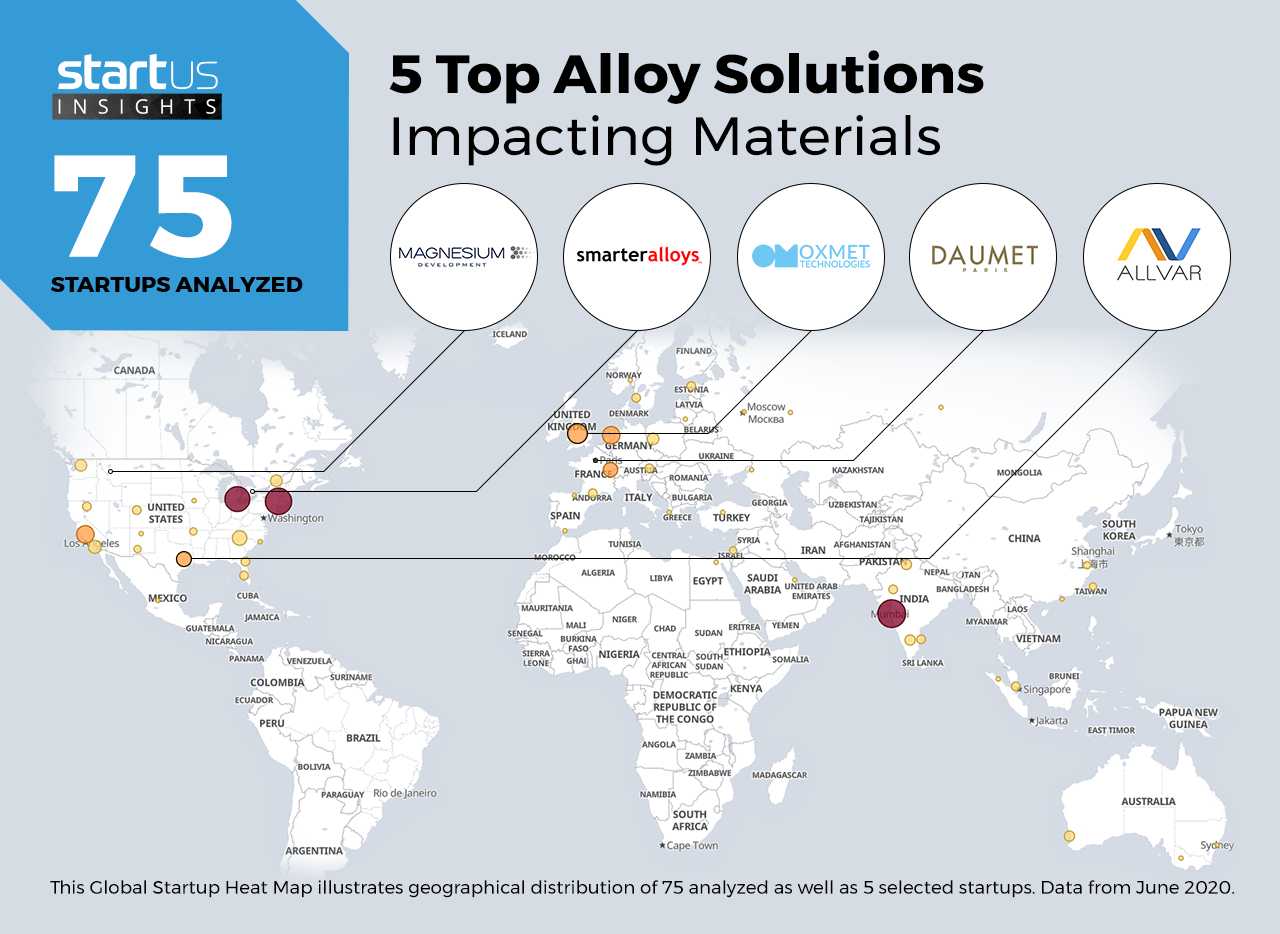Our Innovation Analysts recently looked into emerging technologies and up-and-coming startups working on solutions in the materials sector. As there is a large number of startups working on a wide variety of solutions, we decided to share our insights with you. This time, we are taking a look at 5 promising alloy solutions.
Heat Map: 5 Top Alloy Solutions
Using our StartUs Insights Platform, covering 1.116.000+ startups & emerging companies, we looked at innovation in the field of materials. For this research, we identified 75 relevant solutions and picked 5 to showcase below. These companies were chosen based on a data-driven startup scouting approach, taking into account factors such as location, founding year, and technology among others. Depending on your specific criteria, the top picks might look entirely different.
The Global Startup Heat Map below highlights 5 startups & emerging companies developing innovative alloy solutions. Moreover, the Heat Map reveals regions that observe a high startup activity and illustrates the geographic distribution of all 75 companies we analyzed for this specific topic.
OxMet Technologies – Rapid Design & Optimization
The development of new alloys is a time-consuming process, and the optimization of these alloys for specific applications extends the research and development (R&D) process even further. The introduction of new techniques like metal additive manufacturing is pushing the material science industry to bring out new alloy innovations. Startups are making use of advanced algorithms for accelerating alloy design, development, and optimization process.
UK-based startup OxMet Technologies provides Alloy-by-Design (ABD), proprietary software for rapid design and optimization of alloys. ABD makes use of data such as material properties of elements, thermophysical data, and this data is fed into scientific physical models for simultaneous modeling of the performances of different alloy compositions. ABD allows for both manual and automated optimization for designing new alloys, selecting the most appropriate alloy for specific applications, such as 3D printing, or improving any existing alloy.
ALLVAR – Negative Thermal Expansion
The thermal expansion of metals is one property that is not desirable in many industrial applications. From medical research and aerospace to defense and petrochemicals, many industries use high-end sensitive instruments and components that require a specific coefficient of thermal expansion (CTE).
The US-based startup ALLVAR makes ALLVAR Alloy 30, a negative thermal expansion titanium alloy. The alloy is anisotropic and operates from cryogenic temperatures up to 100° Celsius, and possesses a CTE of -30 ppm/°C at 20°C. Moreover, ALLVAR alloy elements are not toxic and exhibit magnetic properties comparable to other titanium-based alloys.
Smarter Alloys – Shape Memory Alloy (SMA)
SMAs exhibit unique behavior when subjected to mechanical load, electrical current, or temperature change. These alloys exhibit pseudoelasticity and shape memory effects. SMAs, in general, are capable of only a single shape memory and pseudoelasticity. From bioengineering to tubes and wires, startups develop SMAs for different industry applications.
Canadian company Smarter Alloys develops a proprietary Multiple Memory Material (MMM) technology for precisely controlling the pseudoelasticity and shape memory effects. MMM locally programs any material properties into a single shape memory alloy. The phase transformation temperature of the material is set locally for achieving the prerequisite characteristics.
Magnesium Development Company – Bio-Metal Alloys
Fully absorbable implants used in the healthcare industry are mostly based on materials such as bioresorbable polymers or metals. Some polymer-based scaffolds are found to have safety issues that generate interest in the use of specialized metal-based alloys for the same purpose.
The US-based startup Magnesium Development Company produces fully absorbable magnesium-based biometal alloy devices for orthopedic applications. The body absorbs the proprietary magnesium alloy, in a controlled manner, and exhibits higher mechanical strength when compared to performance polymers such as polyether ether ketone (PEEK).
DAUMET – White Gold
Luxury jewelry makers use white gold, an alloy of gold and white metals such as silver, nickel, or palladium. The color of the white gold is not actually white and is usually rhodium plated to conceal this off-white color. The use of metals like palladium and rhodium causes environmental damage as they are rare elements in nature.
French startup DAUMET creates an eco-friendly white gold alloy composed of gold and tungsten. The patented alloy does not require rhodium plating as it is closer to the color white and with a yellowness index less than 19. High density and other material properties also make it a suitable candidate for 3D printing.
What About The Other 70 Solutions?
While we believe data is key to creating insights it can be easy to be overwhelmed by it. Our ambition is to create a comprehensive overview and provide actionable innovation intelligence so you can achieve your goals faster. The 5 alloy solutions showcased above are promising examples out of 75 we analyzed for this article. To identify the most relevant solutions based on your specific criteria, get in touch.




![AI and Pharma: Discover What the Future Holds [2025 & Beyond]](https://www.startus-insights.com/wp-content/uploads/2024/11/AI-and-Pharma-SharedImg-StartUs-Insights-noresize-420x236.webp)




